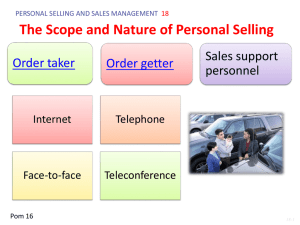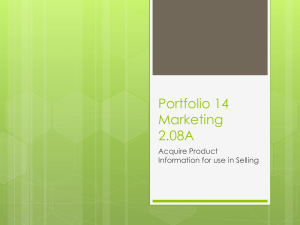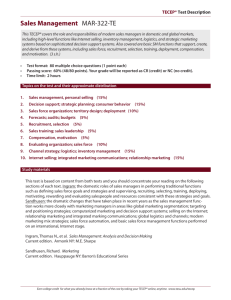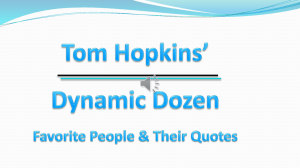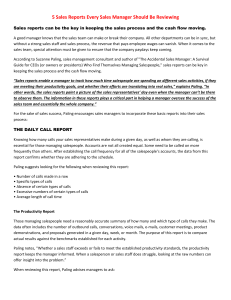Earn the Right to Get the Highest Price Application Article
advertisement
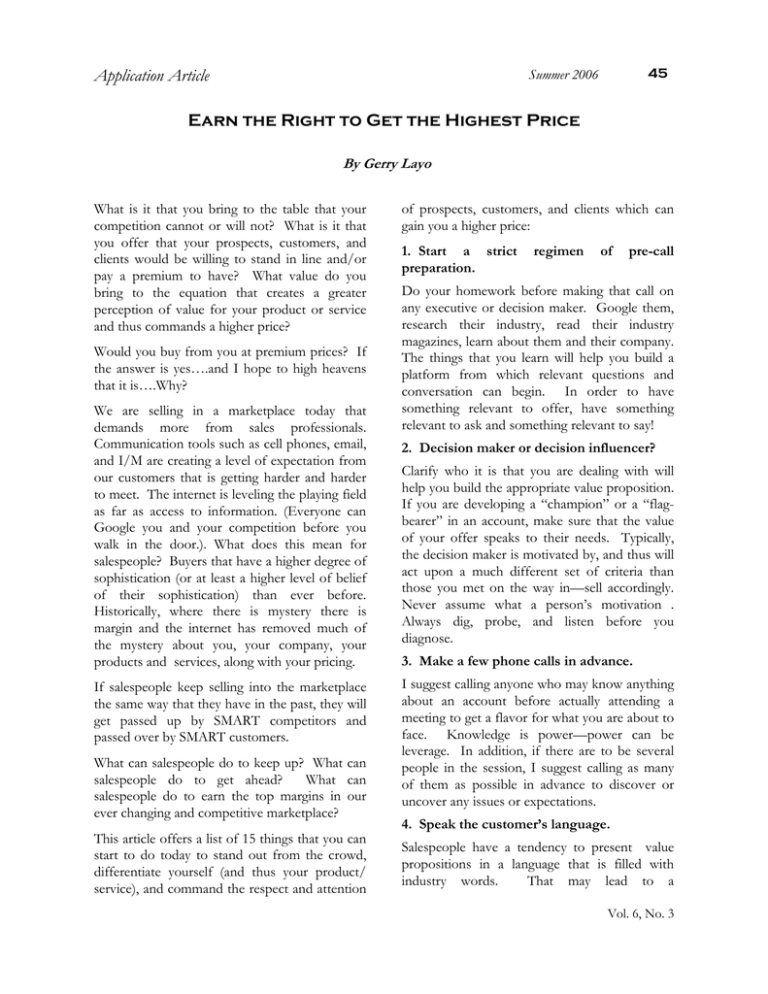
Application Article 45 Summer 2006 Earn the Right to Get the Highest Price By Gerry Layo What is it that you bring to the table that your competition cannot or will not? What is it that you offer that your prospects, customers, and clients would be willing to stand in line and/or pay a premium to have? What value do you bring to the equation that creates a greater perception of value for your product or service and thus commands a higher price? Would you buy from you at premium prices? If the answer is yes….and I hope to high heavens that it is….Why? We are selling in a marketplace today that demands more from sales professionals. Communication tools such as cell phones, email, and I/M are creating a level of expectation from our customers that is getting harder and harder to meet. The internet is leveling the playing field as far as access to information. (Everyone can Google you and your competition before you walk in the door.). What does this mean for salespeople? Buyers that have a higher degree of sophistication (or at least a higher level of belief of their sophistication) than ever before. Historically, where there is mystery there is margin and the internet has removed much of the mystery about you, your company, your products and services, along with your pricing. If salespeople keep selling into the marketplace the same way that they have in the past, they will get passed up by SMART competitors and passed over by SMART customers. What can salespeople do to keep up? What can salespeople do to get ahead? What can salespeople do to earn the top margins in our ever changing and competitive marketplace? This article offers a list of 15 things that you can start to do today to stand out from the crowd, differentiate yourself (and thus your product/ service), and command the respect and attention of prospects, customers, and clients which can gain you a higher price: 1. Start a strict preparation. regimen of pre-call Do your homework before making that call on any executive or decision maker. Google them, research their industry, read their industry magazines, learn about them and their company. The things that you learn will help you build a platform from which relevant questions and conversation can begin. In order to have something relevant to offer, have something relevant to ask and something relevant to say! 2. Decision maker or decision influencer? Clarify who it is that you are dealing with will help you build the appropriate value proposition. If you are developing a “champion” or a “flagbearer” in an account, make sure that the value of your offer speaks to their needs. Typically, the decision maker is motivated by, and thus will act upon a much different set of criteria than those you met on the way in—sell accordingly. Never assume what a person’s motivation . Always dig, probe, and listen before you diagnose. 3. Make a few phone calls in advance. I suggest calling anyone who may know anything about an account before actually attending a meeting to get a flavor for what you are about to face. Knowledge is power—power can be leverage. In addition, if there are to be several people in the session, I suggest calling as many of them as possible in advance to discover or uncover any issues or expectations. 4. Speak the customer’s language. Salespeople have a tendency to present value propositions in a language that is filled with industry words. That may lead to a Vol. 6, No. 3 46 Journal of Selling & Major Account Management problem. The customer doesn’t always know your industry like you do so a “disconnect” or confusion can occur. I suggest that you record your value propositions, presentations, conversations, and questions as often as possible. Get these recordings in the hands of non-industry people and get their opinion. You might be surprised that the reason you are not closing enough sales is that the door to understanding has never been opened due to a language barrier. for those who can and will say YES! 5. Read, learn, grow! Commit to reading a book every month on how to be a better sales professional. You will be amazed at the new moves that you will adopt for your sales success. In addition, read at least 2-3 business or industry magazines every month. You will learn things that you did not know. This can add to your confidence and, if you figure out ways to use this knowledge to differentiate yourself from the crowd (adding value to your customers) it will help you attain your quota and add to your commission or bonus check! Don’t let the “closing” part of your sales cycle be a surprise to your customer. Don’t shy away from it either. Your customer should know that you are there to do business. In order to earn their business, you will have to learn to ask in such a way that it is less painful for both you and the customer. Right now, sit down and write five (5) closing questions that might help you transition from the presentation and negotiation phase to the action phase of the sales cycle. When you have them written, ask them each aloud 100 times until they become less mysterious and thus, natural. 6. Be the quarterback of your sales efforts. 10. Talk Benefits rather than Features. Someone has to call the plays. Make sure that on every interaction with prospects, customers, and clients you clearly define the purpose of the call and stick to it. When the call purpose is met, clearly identify the next steps as well as who is responsible for what. You guide the timelines, you run the plays, and you call the shots. The result will be getting to yes faster. (as well as getting to NO faster…see next item.) The customer does not buy quality, service, reliability, innovation, integration, knowledge, experience, teamwork, or the other features that you are tossing out there in an attempt to differentiate your company. They only buy what those things can do for them or help them do what it is that they want to accomplish. The sooner you start talking about what they GET rather than what it does, the sooner you begin to earn greater margin. 7. Ask for the “yes” once you’ve earned itbut don’t be afraid of the "no". Get out on occasion driving your pipeline business further along towards a yes knowing that the result will most likely be a few fresh "no’s". This is absolutely no a bad thing? Stop wasting your time on those who can not or will not buy from you. A full pipeline of "no’s" is worse than no pipeline at all. The time you invest on qualifying OUT the non-buyers will be well spent once it’s re-invested in prospecting Northern Illinois University 8. Get a coach or a mentor. This sales game can be tough. If you have someone to bounce ideas off and to strategize with, you will have a leg up on the competition. If you think you are good enough to fly solo, think again! Even Tiger Woods has a coach or two on his team. 9. Make the CLOSE a natural conclusion to your professional sales process. 11. Ask them what will happen if they don’t…..? Attempt to attach a cost or a price to in-action or status quo. When your prospects and customers say they are “staying the course with the way they currently do things” you need to help them understand that continuing to do what they are currently doing will only get them more of what they are currently getting. If (and this is a big if) you have attached a PAIN to their Application Article current situation (from their point of view), then you can attach a FEAR of the future. Your product or service at that point becomes the cure to the PAIN and thus, a peace of mind to the FEAR. By providing a solution not just a product/service, it is worth more than what your competitor is selling. 12. Don’t lie—PERIOD! The word character is not used enough in professional sales and it should be. This world of the internet has opened all of our kimonos so there are very few secrets anymore. Often your customer will ask a question that they know the answer to just to qualify your character. You must succeed the 1st time they ask because you won’t get a second shot. (Remember, they are more aware of their options today) Customers pay more for character and trust—count on it! 13. Quid-Pro-Quo This Latin term that means “something for something” or “this for that” and it should be paid close attention to in your dealing with customers. It works both ways. If you are looking for forward movement in the sales cycle or an introduction to others to help you get it, practice quid pro quo from your end first. That means give to get. Give a referral, to get movement. Give an introduction to a lead; get an introduction further into the customer’s circle of influence. Add value first; if you want to get things you value in return. On the flip side we need to understand that when a customer asks us to jump through hoops for them (put together a demo, draw me up an analysis of the benefits, etc.) it is only fair that we now can ask for something in return from them. Example: “We will put together a demonstration of the software, customized to your needs as you requested. If the software performs and meets all of the specifications that we discussed, will you be prepared give us a commitment to move ahead with the purchase that day?” 14. Never make a call without a purpose! In order to be the most productive with your time and the time of your prospects, customers Summer 2006 47 and clients, have a clear purpose for each of your calls. Don’t visit the customer without the express purpose of bringing something of value to the table or moving the sales cycle forward. Don’t make a call to “just check in” or some other nonsense. If you don’t take your call seriously, why should they? By being able to clearly state the purpose of your call and sticking to it, you will become a professional worthy of investing time and money with. 15. Look sharp! If your product / service is similar to that of your competitions, the little things will often be the deciding factors when determining who to go with and how much to pay. Don’t underestimate the fact that people initially form a perception about you and your professionalism based upon your appearance before you ever get a chance to open your mouth. If you want a higher price, you need to look the part! (Use an iron…it’s becoming a lost art!) The use of these 15 points are a good start to get you headed towards attaining quota, selling at higher margins and thus, better commissions / bonuses you can expect. You can see that there are no tricks and no shortcuts. Simply applying yourself in these areas along with, self discipline, commitment, and a customer focused approach will change the customer’s perception of value regarding you and thus, your company, product or service. Gerry Layo is one of the nation’s most dynamic and sought after speaker, trainer, author, and coach. Gerry delivers energizing and innovative world-class keynote addresses, seminars, and workshops. As Head Coach and visionary for Sales Coach International, Gerry is instrumental in using his unique approach to dramatically increase growth and profits for companies throughout North America. He is the author of top selling book: “Smart Selling-Strategies to Reinvent the Sales Process”. For more information visit: www.gerrylayo.com or call 866-979-LAYO (5296) Vol. 6, No. 3

